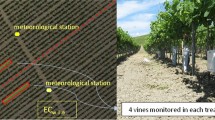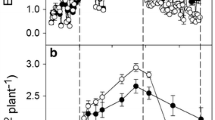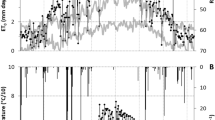Abstract
Seasonal partitioning of evapotranspiration (ET) between transpiration by grapevines (Vitis vinifera) (T gp) and by cover crops of a ryegrass/clover mixture (T cc), and soil evaporation (E s) was performed for a furrow-irrigated vineyard during the 1994/1995 and 1995/1996 growing seasons in south-eastern Australia. ET, determined with a water balance approach, averaged 622 mm. The ET rate averaged over the two seasons increased from 2 mm day–1 in spring (September to November), when it was dominated by T cc, to peak rates of around 5 mm d–1 in summer (December to February) when it was dominated by E s. T gp, determined with either heat-pulse sensors or the Penman-Monteith equation, attained peak rates of 0.75 and 0.98 mm d–1, or 6.2 and 8.1 l vine–1 day–1 in the first and second seasons, respectively. Total seasonal T gp of 109.1 mm (900 l vine–1) in 1994/1995 and 118.8 mm (980 l vine–1) in 1995/1996 constituted just 18 – 19% of total ET. T cc totalled 214 mm (34% of ET) in the first season, when pasture cover was sparse and present for 5 months of the growing season (September to February), and 196 mm (30% of ET) in the second season when pasture cover was heavy but present for only 3 months (September to November). E s averaged 49% of total ET over both seasons. At least 30% of water used for ET was contributed by antecedent soil water in both seasons. The crop factor (K c) was largely constant throughout the season with an average value of 0.48. The depletion pattern of soil water indicated that the vine explored the soil profile well beyond 1.0 mm depth and almost evenly up to a distance of 1.5 m from the trunk. Water use efficiencies for fresh fruit yield (WUE), i. e., the ratio of fruit weight to total water use at harvest,were 13.3 and 40.5 kg ha–1 mm–1 when based on ET in 1994/1995 and 1995/1996, respectively, and 84.0 and 211.1 kg ha–1 mm–1, respectively, when based on T gp. The T gp data were used to verify three models of vine transpiration developed in an earlier study. Models based on the green area index or on fraction of incident radiation intercepted by the vine canopy produced good agreement with T gp. The model based on canopy resistance performed poorly, indicating the difficulty of extrapolating the stomatal response to environmental variables from one set of experimental conditions to another.
Similar content being viewed by others
Author information
Authors and Affiliations
Additional information
Received: 23 September 1996
Rights and permissions
About this article
Cite this article
Yunusa, I., Walker, R. & Guy, J. Partitioning of seasonal evapotranspiration from a commercial furrow-irrigated Sultana vineyard. Irrig Sci 18, 45–54 (1997). https://doi.org/10.1007/s002710050043
Issue Date:
DOI: https://doi.org/10.1007/s002710050043




